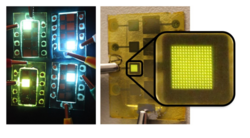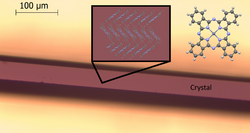Organic Materials for (Opto-)Electronics
Organic optoelectronic devices have proven marketability through widespread application in smartphone and TV display technology. The latest research is driven by the demand for miniaturization of device structures and the extension of molecular functional properties, including novel emissive properties and ultrafast switching.
We investigate electronic excitations of organic molecules in single crystals, in thin films, on the single molecule level, and in full device structures. Our focus relies on revealing fundamental relationships, like the interplay of the optoelectronic properties with chemical environment, molecular structure, morphology, and temperature. This knowledge paves the way for the development of novel functional organic materials.
Our research is application-oriented and aims for novel device platforms, including so-called organic-light emitting antennas (OLEA), electrically‑driven single photon sources, OLEDs with unique emissive properties and ultrafast photo-switches. Find below a list of our current research topics and university collaborations.
Organic Light-Emitting Antennas (Collaboration with Hecht Group (EP5), Universität Würzburg)
Color-switchable subwavelength organic light-emitting antennas
Grimm P, Zeißner S, Rödel M, Wiegand S, Hammer S, Emmerling M, Schatz E, Kullock R, Pflaum J and Hecht B (2022). Nano Letters [DOI]
Innovative OLED and single photon emitters (Collaboration with Steffen Group, TU Dortmund)
Mechano-Stimulus and Environment-Dependent Circularly Polarized TADF in Chiral Copper(I) Complexes and Their Application in OLEDs
Muthig A, Mrozek O, Ferschke T, Rödel M, Ewald B, Kuhnt J, Lenczyk C, Pflaum J and Steffen A (2023). Journal of American Chemical Society [DOI]
Macrocyclic OLED emitters (Collaboration with Würthner Group, Universität Würzburg)
Photon-Correlation Studies on Multichromophore Macrocylces of Perylene Dyes
Müller U, Spenst P, Kagerer P, Stolte M, Würthner F and Pflaum J (2022). Advanced Optical Materials [DOI]
Fundamental properties of molecular single crystals
Spatial anisotropy of charge transfer at perfluoropentacence-pentacene (001) single-crystal interfaces and its relevance for thin film devices
Hammer S., Zeiser C, Deutsch M, Engels B, Broch K and Pflaum J (2020). The Journal of Physical Chemistry C [DOI]
Low-dimensional organic metals for ultrafast photo-switches
Ultrafast Pathways of the Photoinduced Insulator-Metal Transition in a Low-Dimensional Organic Conductor
Smit B, Hüwe F, Payne N, Okaoye O, Bauer I, Pflaum J, Schwoerer M and Schwoerer H (2019). Advanced Materials [DOI]
Our experimental infrastructure comprises purification, fabrication, and characterization tools:
- Purification of molecular materials by gradient sublimation
- Preparation of molecular single crystals by horizontal vapor deposition, electro-crystallization, Lipsett-Growth, Bridgman-Growth and Microspacing-in-Air Sublimation
- Ultra-high vacuum physical vapor deposition for thin film and device preparation
- Structural characterization by X-Ray diffraction and atomic force microscopy
- Optoelectronic device characterization
- µ-Photoluminescence together with lifetime analysis from 4 K to 400 K
- Confocal microscopy of single molecules in combination with photon correlation measurements
If you are interested in a specific topic of our research or are looking for a bachelor or master thesis, feel free to contact Prof. Jens Pflaum for general questions or, for a specific topic, the responsible staff member.





